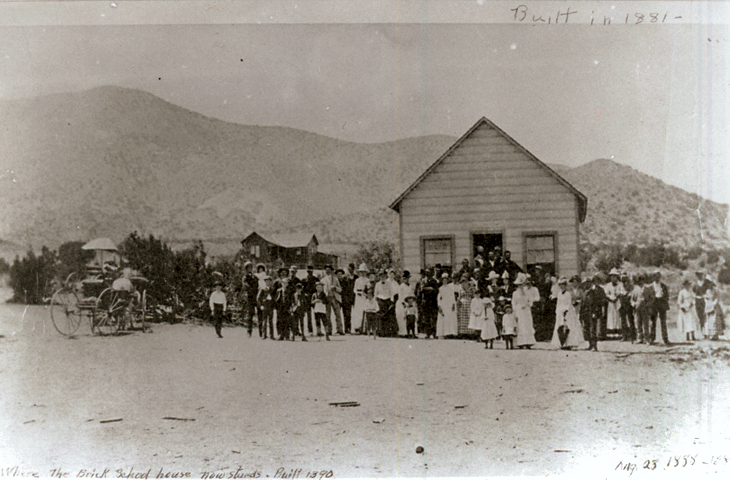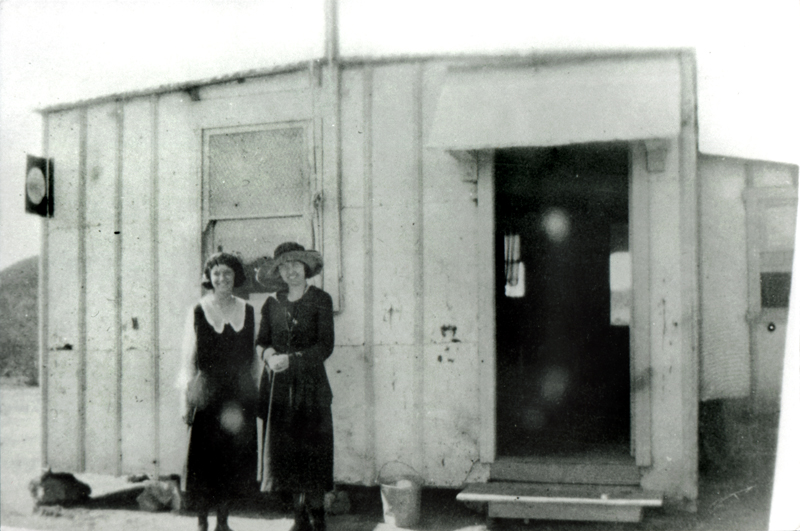Acton School Yearbook, 1968-1969.
Soledad-Agua Dulce Union School District.
|
"School Days" yearbook, 1968-1969, from Acton School — then the only school in the Soledad-Agua Dulce Union School District, forerunner of the Acton-Agua Dulce Unified School District. 5⅛x8 inches, 32 pgs. octavo. Issued to Terry Billet, daughter of Ray and Elizabeth (Blum) Billet of the Blum Ranch in Aliso Canyon, Acton. Children's names were not published; if you recognize yourself (or someone else), please tell us in the comment section below.
Early History of the Acton-Agua Dulce Unified School District. The Acton-Agua Dulce Unified School District started out as two separate school districts, Acton being the older of the two — although it wasn't called "Acton," and its schoolhouse wasn't located in Acton. It was called "Soledad," and it was in the Ravenna area to the southwest. According to standard accounts (including the school district), the forerunner of the AADUSD was established in 1881. This is incorrect. It's older. And not just because both of our major local 20th-century historical researchers, Meryl Adams of Acton and A.B. Perkins of Newhall, say so. They tell us — Perkins in 1954, Adams in 1988[1] — that Dennis Searles, no doubt the Dennis Searles of Mojave Desert fame, filed a petition to form the Soledad School District in June 1869, and as such, it was the oldest district in Los Angeles County. We're still searching for primary source documents to support that assertion — but we do find primary sources proving the district existed by January 1878. A published report in that month lists the Soledad School District as a recipient of per-pupil state funding (ADA), distributed out of the county allotment.[2] For the 1878-1879 school year, the Soledad district received a whopping $29 from the state. This amount represents $1.01 per pupil,[3] so we can deduce the enrollment figure. (In comparison, Newhall got $53; the Castaic, Saugus and Sulphur Springs districts didn't exist.) The Soledad district got a big raise in 1879-1880. In that year, instead of per-pupil funding, the state paid $80 per teacher. Soledad got $80.[4] (Sulphur Springs first appears in 1879. It also got $80, as did Newhall.)
The original Soledad school was not where (or when) most sources put it. Most say the district's first school was the Little White School on Cory Avenue in Acton, established 1881. While it might have been the first school in the actual town of Acton, it wasn't the first in the district, and it wasn't built in 1881. There was no Acton then. Acton's first permanent residents, the John F. Duehren family, didn't arrive until 1885. In fact, the Little White School came along in 1888 and doubled as a church. Records of the contemporary Acton Community Presbyterian Church show the congregation first met April 28, 1888. It's an old error. Long ago, someone mistakenly hand-wrote "Built in 1881" on an 1889 R.E. Nickel photograph of the Little White School. In a 1951 Los Angeles Times interview, the former Miss Lydia Duehren (married name Lydia C. Newton), who arrived with her family in 1885, recounted her school days. Per the Times: "She recalls that the first Soledad school she attended was located a mile south of Ravenna near what is now the McCarthy ranch."[5] That's a few miles from Acton. Historian Adams describes the schoolhouse as approximately 12 by 16 feet, located just just inside the McCarthy Ranch field to the left of the gate. ... The furniture of the adobe schoolhouse was all home-made, including the teacher's desk. There were two rows of seats, each seat held three pupils. The last year school was held in this building was 1887. Unfortunately, Adams doesn't divulge her information source.[6] Per the 1951 Times article, Lydia Duehren next attended the Little White School when it opened in 1888 on the hill at the end of Cory Avenue. It lasted just two years. The wooden school-church building was taken down and moved off the property to make way for the Soledad district's third school, a more substantial red brick structure, which Lydia also attended — as would her seven children. (All sources agree the red brick school was completed in 1890. It says so right on the building in old photographs.) Meanwhile in Agua Dulce, families raised honey, chickens and other livestock, and after the turn of the century, several men were engaged with the Sterling Borax mining operation at Davenport Road. "Dad" Johnson arrived in Agua Dulce with his wife and eight children in 1914, and finding no school there, he donated land to be used for the enlightenment of his and everyone else's children.[7] The townsfolk rallied and built a 6x6-foot board-and-batten shack on the property at the present 34769 Agua Dulce Canyon Road. Meryl Adams writes (pg. 201):
The entire community built this building; it was for the people, children and adults. In addition to school, dances were held there on Saturday nights. Sunday school, suppers, church services and community meetings began to use the new school within a few years.
In 1925, the borax operation having gone dark, the more substantial wood-frame Sterling school[8] was acquired and moved (apparently in 1926) from its original location — in the company town of Lang in Tick Canyon below the mine — to the ex-Johnson property, replacing the 1914 shack. With it came its furniture and fixtures and several hundred dollars in school funding.[9] Further research is required, but this suggests the Sterling was a separate school district and was dissolved and absorbed into the Agua Dulce School District at that time.[10] The Sterling-turned-Agua Dulce schoolhouse survives today as a church. Back to Acton. By 1935, the growing community needed a bigger schoolhouse. Acton residents voted to put up half the funds for a new school through a $6,000 bond measure,[11] and the Works Progress Administration, a federal New Deal program (renamed Works Projects Administration in 1939), funded and built the other half. The first wing of the current Acton School at 32248 Crown Valley Road was built in 1938. It's unclear whether it opened for the 1938-1939 or the 1939-1940 school year.[12] Evidently, the red brick schoolhouse was abandoned after the 1936-1937 school year. Historian Adams indicates the old CCC camp, which later became the Acton Rehabilitation Center, was used for schooling in 1937-1938.[13] Unification of the Agua Dulce district and the larger Soledad district, to become the "Soledad-Agua Dulce Union School District," came a decade later. Both school boards agreed to merge in the summer of 1947. The "union" (merger) district would have a 5-person school board: initially three from Agua Dulce (Mary O. Sciarra, Clarence H. Jones and Fred M. Eckles) and two from Acton (Justin S. Edwards and Rubey E. Blum, often spelled Ruby Blum).[14] At the time, traditional one-campus districts had three school board members and "union" districts had five.[15] Not everyone was happy with the merger. When put to a vote, it passed, 212-67. But the breakdown is more telling. Knowing Agua Dulce kids would schlep to Acton and not the other way around, Acton voted overwhelmingly in favor (185-5), and Agua Dulce voted overwhelmingly against (27-62).[16] The schlepping began at the start of the 1948-1949 school year. The "Soledad-Agua Dulce Union School," aka Acton School, had a reported enrollment of 100 pupils.[17] The 1949-1950 school year began with four teachers: Mrs. Young (grades 1-2), Mrs. Lathrop (3-4), Mrs. Goldie Dawson (5-6) and Harold Richard, the principal (grades 7-8). Seventy-two pupils rode the bus to school, and another 61 rode the high school bus to the new Hart campus in Newhall.[18] By now a second wing of the school was in the works. School board President Ruby E. (Kingsbury) Blum — mother of the future Mrs. Elizabeth Billet — led the groundbreaking ceremony on May 24, 1949.[19] According to Adams (pg. 332): "Construction was done during summer 1949, completed by end of October and ready for use, November 1949." A third wing was completed in the summer of 1952. We'll pick up the story when we figure out when the Soledad-Agua Dulce district changed its name to Acton-Agua Dulce. It was after 1969. — Leon Worden 2020
1. Meryl Adams 1988: pg. 9. 2. Los Angeles Herald, 1/30/1878, which is the earliest such report we've found. 3. Los Angeles Herald, 8/29/1878. In all of Los Angeles County only 10,446 pupils attended school in 1878-1879 — up from 9,319 in 1877 and 7,787 in 1876 (Daily Alta California, 2/26/1876, and Santa Barbara Daily Press, 3/2/1877). 4. Los Angeles Herald, 8/31/1879. 5. Los Angeles Times, 6/3/1951. 6. Meryl Adams 1988: pg. 9. 7. Meryl Adams 1988: pg. 201. 8. See The Newhall Signal and Saugus Enterprise, 3/23/1923. It was substantial enough for 50 people to attend a going-away party for borax company chemist T.W. Woodbridge, complete with dancing and electric lights. 9. The Newhall Signal and Saugus Enterprise, 9/17/1925. Note that a conflicting one-sentence remark in The Signal of 10/22/1925 states that Mr. and Mrs. Frank Mitchell (of present-day Canyon Country) bought the Sterling schoolhouse. While that's possible, the report of September 17 is more thorough and more likely. The 1914 Agua Dulce school was indeed replaced in 1926. 10. See The Newhall Signal and Saugus Enterprise, 6/3/1926. It's not much, but an obituary for a 24-year-old woman, Miss Blanche Evelyn Woldien, states that she attended school in Agua Dulce until "it was found, when the Sterling school was established, that she belonged in that district, and continued her grade work there, graduating six years ago." 11. Meryl Adams 1988: pg. 308. 12. See Meryl Adams 1988: pg. 319. 13. Meryl Adams 1988: pg. 307. 14. The Newhall Signal and Saugus Enterprise, 7/3/1947. 15. Note that the dissolution and absorption of the Sterling district into the Agua Dulce district was not a "union," just as the dissolution and absorption of the Felton School District into the Newhall district did not make Newhall a "union" district. A union is a merger of two or more viable school districts. A district that falls below the state's minimum required enrollment is not a viable district. 16. The Newhall Signal and Saugus Enterprise, 5/6/1948. 17. The Newhall Signal and Saugus Enterprise, 9/30/1948.
Yearbook purchased by Leon Worden from Billet Family/Blum Ranch estate sale, 2/24/2020. Download individual pages here. Photo file.
|


